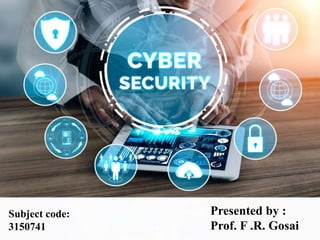
Cybersecurity
- 1. Presented by : Prof. F .R. Gosai Subject code: 3150741
- 2. Course Unit 1: Systems Vulnerability Scanning Unit 2: Network Defence tools Unit 3: Web Application Tools Unit 4: Introduction to Cyber Crime and law Unit 5: Introduction to Cyber Crime Investigation
- 3. The term cyber security is used to refer to the security offered through on-line services to protect your online information. With an increasing amount of people getting connected to Internet, the security threats that cause massive harm are increasing also. Introduction
- 4. What is the meaning of the word CYBER What is the need of Cyber Security What are the security problems in Cyber field How to implement and maintain Security of a Cyber field around us.
- 5. It is a combining form relating to information technology, the Internet, and virtual reality. Meaning of the Word CYBER
- 6. Need of cyber security Cyber security is necessary since it helps in securing data from threats such as data theft or misuse, also safeguards your system from viruses.
- 7. Major security problems Virus Hacker Malware Trojan horses Password cracking
- 8. Viruses and Worms AVirus is a “program that is loaded onto your computer without your knowledge and runs against your wishes
- 9. Solution Install a security suite that protects the computer against threats such as viruses and worms.
- 11. Hackers In common a hacker is a person who breaks into computers, usually by gaining access to administrative controls.
- 12. Types of Hackers White Hat Hacker Grey Hat Hacker Black Hat Hacker
- 13. How To prevent hacking It may be impossible to prevent computer hacking, however effective security controls including strong passwords, and the use of firewalls can helps.
- 14. Malware The word "malware" comes from the term "MALicious softWARE." Malware is any software that infects and damages a computer system without the owner's knowledge or permission.
- 15. To Stop Malware Download an anti-malware program thatalso helps prevent infections. Activate Network Threat Protection, Firewall, Antivirus.
- 16. Trojan Horses Trojan horses are email viruses that can duplicate themselves, steal information, or harm the computer system. These viruses are the most serious threats to computers
- 17. How to Avoid Trojans Security suites, such as Avast Internet Security, will prevent you from downloading Trojan Horses.
- 18. Password Cracking Password attacks are attacks by hackers that are able to determine passwords or find passwords to different protected electronic areas and social network sites.
- 19. Securing Password Use always Strong password. Never use same password for two different sites.
- 20. CyberSecurity Is Everyone’s Responsibility
- 21. Cyber crime growth by year
- 22. Cyber Security Strategy – India • Security Policy, Legal Framework – ITAct, 2000 – IT (Amendment) Bill, 2006 – Data Protection & Computer crimes • Capacity building – Skill & Competence development • Research and Development – Cyber Monitoring – Network Security • International Collaboration
- 23. Biggest Cyber Attack in 2020 Magellan Health
- 24. Marriott
- 25. Software AG Ransomware Attack
- 26. Twitter
- 27. Zoom
- 28. Types of Attack. Malware Phishing Salami Attack SQL Injection Attack Cross-Site Scripting (XSS) Denial of Service (DoS) Session Hijacking and Man-in-the-Middle Attacks Credential Reuse Nigerian Scam Dumpster diving War driving Ransomware
